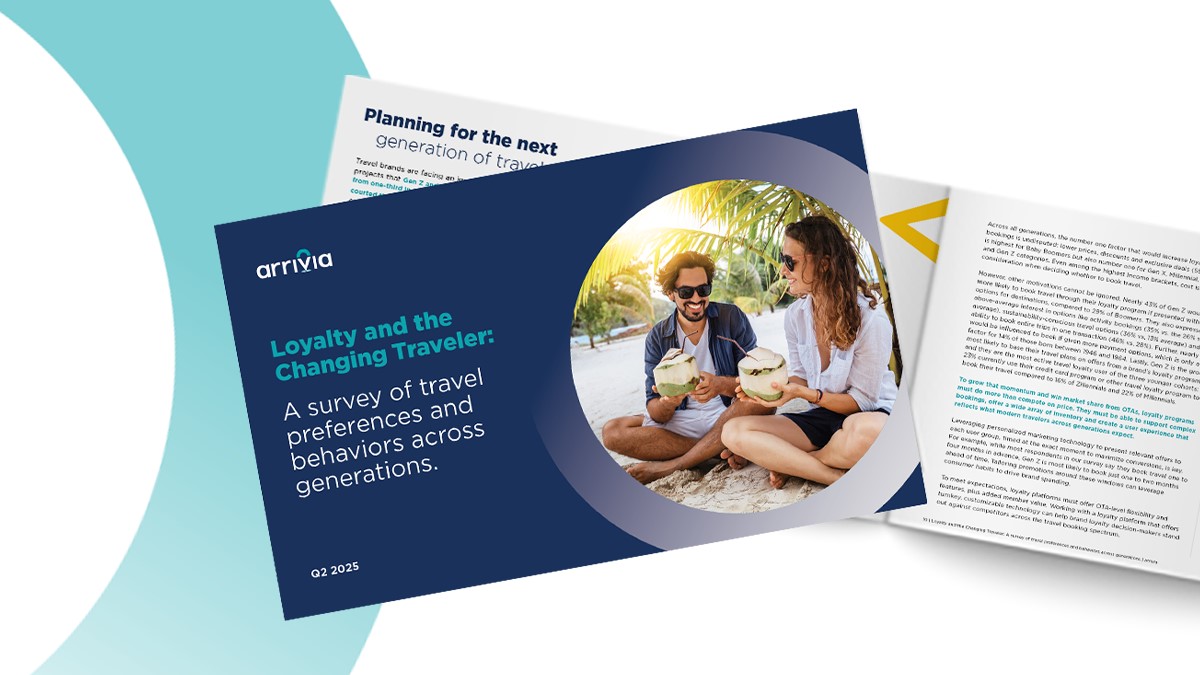Travel loyalty programs have a rich history and remain incredibly popular among consumers. And there is a full spectrum of travel loyalty programs currently in the market, with some functioning like full-service travel agencies with sophisticated earning and redemption processes on one end and others offering members discount codes to travel vendors. The common thread is that they provide travel-related rewards to members in exchange for their loyalty or participation.
But that’s the bare minimum. Imagine you had to (or wanted to) build a travel loyalty program from scratch without any previous examples or templates to build on. What would you absolutely need to have? What would make it the best travel loyalty program it could be?
At arrivia, we’ve given this some thought, as you might imagine. We’ve developed six critical components of a travel loyalty program and explained why excelling at these aspects is essential for making a minimally viable program into a standout competitor in the crowded loyalty market.
1. Value
Number one is always value. If all travel loyalty programs offer travel-related benefits as incentives for specific customer behavior or loyalty rewards, then members must find those benefits valuable. Whether that value comes from a deep discount, exclusive travel opportunities, or not-available-to-the-public base pricing, it’s the cornerstone of any successful travel loyalty program. Consumers agree—according to an arrivia survey of American travelers conducted in early 2022, “value for money” is consistently the most important consideration for travelers planning a trip.
Travel loyalty programs that excel at this component leverage every advantage they have to deliver maximum value to members. That includes using their defined membership structures to secure below-market pricing on travel products or configuring their earning and redemption processes to create recognizable value for members.
2. Travel options
A travel loyalty program that doesn’t offer travel options isn’t a travel loyalty program at all. Programs that align their rewards and earning processes with one travel product can be successful – think of the first iterations of frequent flier programs – but at this point, the expectation is that a travel loyalty program will offer a range of travel options to members. The basics are the big three: air, hotel, and car rental.
The most successful programs often go well beyond those core offerings, making cruises, tours, resort stays, travel insurance and other complementary travel products and services available to members. The best travel loyalty programs can meet a member’s whole-trip needs and having a wide array of travel options is central to that aim.
3. Booking capability
Not every travel loyalty program allows members to book travel within the program itself. Even some well-recognized programs provide discounts or points redemption but send members to a separate site or agent to complete a travel booking. At arrivia, we would argue that booking capability is a crucial component. Successful travel loyalty programs often partner with a technology provider that offers a white-label booking site with single sign-on capabilities, so members stay within the branding and interaction experience of the loyalty program when booking travel.
If one of the top priorities of any loyalty program is to increase and improve member engagement – and it is – then keeping members within the travel loyalty program’s ecosystem through the completion of a booking is instrumental to achieving that goal. That engagement can also extend beyond the immediate trip: travelers utilize travel booking websites as sources of inspiration when planning and dreaming of their next excursion. Arrivia survey data shows that 43% of travelers do this, almost double the amount that refer to travel publications for research (22%). The best travel loyalty programs understand this and strive to create a one-stop-shop for all a member’s travel needs, including the all-important booking itself.
4. Flexible currency
Points, miles, or credits are present in nearly every loyalty initiative and are essential to travel loyalty programs. They’re the currency of the loyalty program economy, providing a framework that quantifies what members earn and receive in exchange for participation. But in their most straightforward, most basic forms, loyalty currencies can be too rigid to meet the sophisticated aims of modern travel loyalty programs. Currencies with a static value or a points-to-cash equivalency can hinder programs’ ability to reward members effectively or incentivize new sign-ups.
Having a flexible loyalty currency is a hallmark of highly successful travel loyalty programs. The ability to modify points’ value, integrate new savings with existing currencies, and fund bonus points or miles through the margin earned on other travel products gives loyalty programs the flexibility to reward different members for different actions or activities and create valuable incentives for key membership thresholds, like joining or reaching a new status tier. A flexible loyalty currency also enables programs to run point-multiplier offers to create specials or encourage bookings during a specific time window, like “earn 3X points on cruises booked before October 1st.”
5. Customer service
Every travel loyalty program has some mechanism for servicing customers, but as you undoubtedly know, not every customer service experience is created equal. While technology has introduced some efficiencies, chatbots and automated customer service prompts should only complement a full-service member support program that can handle and address travel-related disruptions and irregularities.
It’s not just about resolving member inquiries and issues, however. The best travel loyalty program customer service departments are trained to recognize opportunities to bundle tours and experiences into packages that include hotel, rental car and airfare, and work with members to find the best options. This helps boost member satisfaction and drive per-trip spending and redemptions.
6. Marketing
The final key component of a travel loyalty program is the ability to market and advertise to prospective and current members. Even if a program optimizes all the other vital details, if members aren’t aware of the program’s benefits or aren’t encouraged to take advantage of them, that program will wither. Well-planned and executed marketing strategies keep members engaged and active within the travel loyalty program and help attract new members to it.
A travel loyalty program that employs intelligent marketing can use information gathered from the member’s digital footprint to create targeted and relevant travel content that best meets their individual needs, thereby increasing the likelihood of conversion. The best programs consistently reach out to prospective members with effective messaging and onboarding incentives.
If you were to build a travel loyalty program from the ground up, mastering these six components would provide a solid foundation to set your program up for success. Fortunately, businesses and organizations don’t have to create their programs from scratch – that’s what we’re here to help with.



